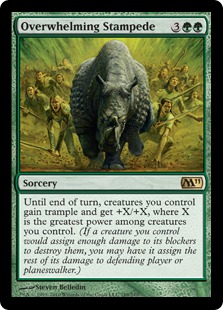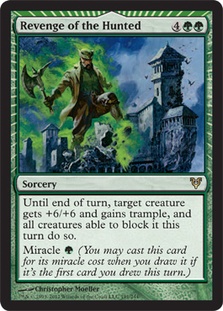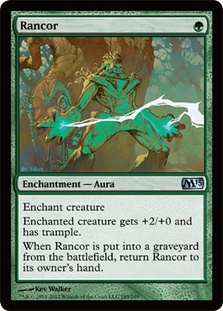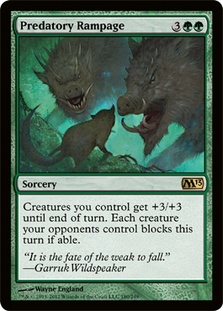I’ve been in love with Dungrove Elder for a long time. Longtime readers will know that I was turned onto the card in Pittsburgh by Khyler Fields, a young player who managed a respectable Top 32 finish with a more midrange-based Dungrove Elder deck in the summer of 2011. After that event, I kept plugging away at various different Dungrove Elder lists, finally merging the things I liked about Khyler’s list with some awesome ideas from Andrew Shrout Elf-based beatdown deck. In the end I had a deck that was doing phenomenal for me on Magic Online, but it was too late: there simply wasn’t enough time left in the format to do much with it. Here is that last deck:
Creatures (25)
- 4 Llanowar Elves
- 4 Lotus Cobra
- 1 Arbor Elf
- 4 Leatherback Baloth
- 4 Vengevine
- 4 Sylvan Ranger
- 4 Dungrove Elder
Planeswalkers (3)
Lands (23)
Spells (9)

The real killer spell in the deck was Overwhelming Stampede.
Okay. Overwhelming Stampede is just absurdity. Absurdity beyond absurdity. Aaaaand, unfortunately, it also slipped out of print.
I kept looking for replacements, but I never really saw anything that made me feel good about it.
One card that I’ve seen a lot of people turn to is Revenge of the Hunted. This is, in fact, an incredibly powerful card, especially if you can put people on the back foot. Still, though, I just wasn’t sold on the card fully. Too often, I’d see moments where it was stymied by a Vapor Snag, a Gut Shot, a Doom Blade, or any other number of cards, not to mention simply being drawn during the opening hand or at an inopportune time where you couldn’t really afford to just go for it and get any effective work done with the card.
I was looking for something else.
As the M13 spoilers came out, fairly early on was a single card that really was incredibly exciting. They were reprinting this insanely good gem:
I wasn’t the only one to have their eyes bug out, I’m sure. I gathered a group of friends together for a Magic Online PTQ, and while none of us performed nearly as good as we would have wanted, it was a lot of fun. Between rounds, we mostly talked about Magic, and the topic of this fabulous collection of cards came up:
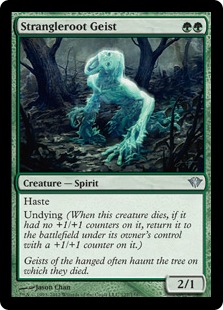
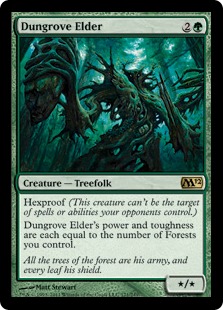
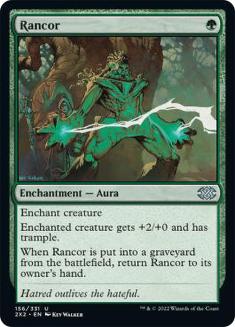
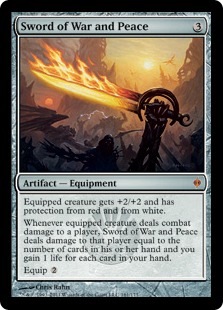
Throw in Green Sun’s Zenith if you want, but however you add it up, you have some incredibly impressive potential aggressive draws. Rancor is just amazing to begin with, but it has this fabulous ability to make two good cards, Dungrove Elder and Sword of War and Peace, become even better.
The big issue with both of these cards is that sometimes you just don’t actually get to connect with them and you lose so much of their value. Rancor can help make connecting with a creature holding a Sword much more realistic, and if it resolves tends to guarantee that Dungrove hits.
I had an initial list of this deck prior to the full release of M13, but it was still, as I said then, very much a beta build of it.
Here is the list, pre-M13:
Creatures (28)
- 4 Llanowar Elves
- 3 Birds of Paradise
- 4 Borderland Ranger
- 1 Thrun, the Last Troll
- 3 Phyrexian Metamorph
- 4 Dungrove Elder
- 1 Avacyn's Pilgrim
- 1 Daybreak Ranger
- 4 Strangleroot Geist
- 2 Predator Ooze
- 1 Ulvenwald Tracker
Lands (22)
Spells (10)

After M13, of course, Rancor was so much on everyone’s radar that it seemed inevitable that a ton of people would jump on the concept. In fact, we did see a large number of people hop on it. Take this bit of video on Adam Boyd build:
Here is his deck:
Creatures (23)
- 3 Llanowar Elves
- 2 Birds of Paradise
- 4 Arbor Elf
- 4 Dungrove Elder
- 2 Skinshifter
- 4 Strangleroot Geist
- 2 Wolfir Silverheart
- 2 Champion of Lambholt
Lands (24)
- 24 Forest
Spells (13)

There is a lot here that I actually strongly, strongly dislike.
Skinshifter, I think, is just too fragile and unreliable, particularly if you have to sink mana into it and can just get punished for doing so. I can’t say I would recommend that card at all.
Wolfir Silverheart is completely awesome when helping out a Rancored creature or to pop onto a Birds of Paradise or Champion of Lambholt. But at the same time, I just don’t think that the deck needs to be doing anything like this. There are plenty of cards you can use to kill your opponent; I think you need to be doing something else on top of it. Like Silverheart, Champion does seem like it does something—it is a very reasonable Bellowing Tanglewurm replacement—but it needs help to make that happen, and things can just go wrong.
Even Adam regrets his choice of Revenge of the Hunted in the deck. I know that when I was talking to Jackie Lee about her use of Revenge of the Hunted in her Dungrove deck for SCG Open Series: Worcester, she was very happy with it, but all weekend I just kept seeing Revenge of the Hunted first stranded in someone’s hand then answered handily by singleton removal spells. Adam thought it wasn’t what he wanted to be doing because it just ended up requiring too much to be going right in order to work. That said, it can do some incredible work; it just needs to not actually have any real resistance hitting up against it to do it.
Finally, I look at this list and ask myself, “Where are the Borderland Rangers?” Even without the need for fixing, I love Borderland Ranger. If you scroll up the page a little bit, you’ll see that the Dungrove Elder list that I was incredibly happy with ended up with four Sylvan Ranger. It was just that the card let you end up “cheating” on the amount of mana that you were running and, at the same time, greatly reduced the amount of mana that is in your deck.
Now, I know that you may be saying to yourself, “Adrian, it only takes one land out of your deck. That isn’t much of a thinning effect.” But that isn’t looking deep enough.
Take Adam’s list. It runs 24 land. If we just kept Adam’s list as is but found room for four Borderland Ranger, it’s true that a single Borderland Ranger wouldn’t do much to thin the deck of mana. The thing is that you don’t need to have nearly the amount of mana. Take a draw from Adam’s deck where, say for the sake of argument, he drops a second turn Borderland Ranger and fetches the third land from his deck (for a total of three so far this game, let’s say). This means that there are 21 lands in the deck out of 50 cards (on the play).
Compare this to a deck that is built with Borderland Ranger in mind and only runs 21 or 22 lands to start. Here, you are now down to 18 lands out of 50 in the same situation. This isn’t a miniscule reduction; it’s actually a very significant one. So long as you build your deck with sufficient mana, the Borderland Ranger ends up drastically reducing your mana. There is a reason I included Civic Wayfinder (the Elven version) in the Elf deck that I gave to Sam Black that he took to his US Nationals finals a few years ago.
I started off with this in the pre-M13 list, but looking at the lists from the SCG Standard Open in St. Louis, I was deeply struck by Caleb Durward’s choice to include Elvish Visionary in his Top 8 list from the event [note: at the time of this writing, the Top 4 had not yet played]. This reminded me very much of the inclusion of Sylvan Ranger in my Dungrove deck and the way it played out with Overwhelming Stampede.
This brought me back to the card I’ve been thinking about for quite a bit for this archetype. This card I think will be quite an upgrade from Revenge of the Hunted:
While it doesn’t give the trample that Revenge of the Hunted gives, it does give more creature kill potential, it busts open mirror and “near-mirror” matches, and it doesn’t fall prey to singular point-and-click creature removal to nix it like Revenge does. It typically gives a similar amount of extra damage as Revenge and often gives a lot more.
I’d come to Predatory Rampage before the event and I tried to talk former Wisconsin State Champion Jed Grimmer into playing the card, but he ended up with Revenge of the Hunted instead. I asked him to pay special attention to when he drew Revenge, and in the end, he said he wasn’t sure but thought that perhaps Predatory Rampage would have done exactly what he wanted. He said he definitely felt like Revenge got stranded in his hands where a Rampage would have been very effective.
It is only after all of these things came together that I started really feeling good about the deck.
Then I saw Michael Alakayleh Top 4 with this deck:
Creatures (23)
- 3 Llanowar Elves
- 4 Birds of Paradise
- 1 Viridian Corrupter
- 4 Dungrove Elder
- 4 Strangleroot Geist
- 3 Predator Ooze
- 1 Wolfir Silverheart
- 2 Ulvenwald Tracker
- 1 Thragtusk
Lands (24)
- 24 Forest
Spells (13)

He did use Revenge of the Hunted to good effect. As funny as this is to say, afterwards I still wasn’t incredibly excited by the card; it struck me that his Revenge of the Hunted success only came about because his opponent made some plays that opened the door for the card to work, when it didn’t need to be done that way at all.
All of that said, I loved seeing his deck running a combination of Ooze and Ulvenwald Tracker.
I’d been excited about the Tracker for some time, and Brian Kowal was trying to get me to fit a second Tracker into the deck on top of the one I was running in the maindeck. I struggled to find the room, but watching Michael’s deck play out and listening to Adam Boyd talk about how unhappy he was with Sword of War and Peace, I decided maybe I was just living in the past with my Swords in the main and needed to let go.
Here’s where I came to:
Creatures (29)
- 4 Llanowar Elves
- 2 Birds of Paradise
- 4 Elvish Visionary
- 4 Borderland Ranger
- 3 Arbor Elf
- 4 Dungrove Elder
- 4 Strangleroot Geist
- 2 Predator Ooze
- 2 Ulvenwald Tracker
Lands (20)
- 20 Forest
Spells (11)

I was convinced by Sam Black that dropping down in Green Sun’s Zenith would be acceptable. Yes, Green Sun’s Zenith at four mana is just another Dungrove Elder, but that extra mana on that turn often really does matter. You tend to spend all of your mana every turn, and each bit of mana you spend can actually end up building up your mana on the next turn as well; that little bit of mana that you expend into the GSZ can catch up with you. When it boils right down to it, you aren’t really doing all that much Tutoring, with Green Sun’s Zenith making you feel like you have the equivalent of three Ulvenwald Tracker and four Predatory Ooze.
The split on Arbor Elf and Birds of Paradise is basically one where you are trying to balance out the question of +1 power versus flying. I’m not certain of this split yet, but for now I’m trying it out so that I have a small amount of Birds as a potential chump blocker or way to make Dismember less painful. But I’m leaning more towards the extra damage because this is a deck that ultimately plans on attacking. It may not matter much, but I simply don’t have enough information to know which way to lean yet. As a deck with Tutoring capabilities, I think there is some value in the split.
Predatory Ooze is actually just really good right now. There certainly are answers to the card. The issue is that a lot of decks just don’t have very many of them, and some decks have almost no (or even no) answers to it. Being great against Bonfire of the Damned, holding off aggressive decks very well, resisting Day of Judgment, and just generally being a total monster with Rancor or Ulvenwald Tracker makes this card an MVP.
The sideboard includes a Swamp as a means to both up the land count when your mana curve jumps up and as a way to stem the bleeding on Dismember, if only by a little bit. Should Ramp come back into the meta, you’d also be able to include Memoricide, but I, for one, am hoping that Primeval Titan is basically done with. Of course, it may not be. Argh. Frown.
While still in the development stage, I’m pretty excited about how this deck’s test draws have been playing out. I was playtesting a slightly earlier version of this deck before I added in the Visionaries and dropped the Swords, and I was quite happy with it. This version, unfortunately, I’ve only done some test draws with, but it plays out smoothly and reminds me enough of the previous version that I feel like many of the draws from that earlier version are absolutely worth drawing upon.
It could well be that I am going to want to reintroduce the Sword of War and Peace. I don’t know yet, but I intend to find out. I just know that regardless of that, I’m hoping that by the time this article sees print, we’ll see another Dungrove Elder deck at the top of the event.
Until next week,

